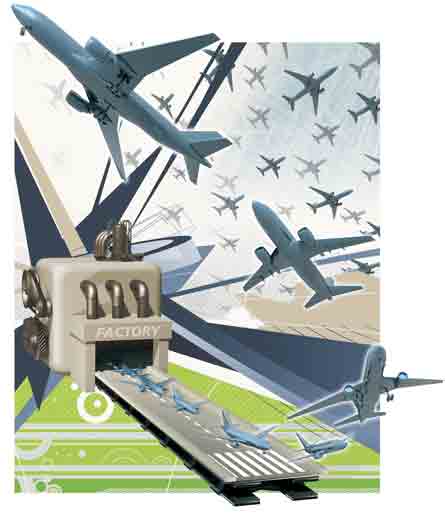A spate of flotations and the sale of several major lessors confirm that many in the industry see this as an opportune time to be raising money
Leasing companies have rarely had it so good. After a turbulent couple of years in the early part of this decade, when many lessors were discreetly or not so discreetly put in the shop window by their shareholders, leasing companies have become hot property.
Although a recovery from the post-2000 downturn was inevitable, few predicted it would be so robust. "I wouldn't have expected the market to be this strong - but I'm a glass half-empty kind of guy," says market pessimist GECAS chief executive Henry Hubschman.
|
|---|
While lease rates in 2006 may not have seen the stellar gains that were experienced during the rapid bounce back of 2004 and 2005, they have, nonetheless, held their own, and lessors report that they are managing to get longer lease terms. "Some airlines are taking leases of 10 or even 12 years," says Jeff Knittel, chief executive of CIT Aerospace. "In 2006, lease rentals exceeded expectations for most aircraft types with the exception of the McDonnell Douglas aircraft," notes Klaus Heinemann, chief executive of AerCap. The need for interim lift to cope with Airbus A380 delays has seen a strong widebody market, lessors report.
Against this background, as Singapore Aircraft Leasing Enterprise (SALE) chief executive Rob Martin puts it: "Capital markets are open for leasing companies." SALE itself was purchased by Bank of China (BOC) late last year for $965 million.
The biggest deal of 2006 in pure cash terms saw AWAS change hands (see box story on p47). Morgan Stanley, which bought AWAS shortly before 9/11, sold out to private equity firm Terra Firma in a $2.5 billion plus liabilities deal. Also making waves was Macquarie, which seems to be in the bidding for most things aviation-related at the moment, purchasing the GATX fleet (minus jointly owned aircraft) for $1.25 billion. "GATX had no long-term vision or clear long-term strategy, and had become portfolio managers rather than active lessors," comments one leasing company head. "This allowed Macquarie to take over the assets without taking on a large management structure." Earlier in the year GATX and Rolls-Royce also sold their 50%-each shares in Pembroke in a management buy-out.
Q Aviation and Pegasus Aviation are on the market too, suggesting that the churn is not over yet. There has also been a spate of initial public offerings. Late last year, Cerberus Capital-owned AerCap raised around $600 million through an IPO on the New York Stock Exchange (NYSE). And this was preceded by an IPO for Fortress Investment Group's AirCastle in August, also on the NYSE, that raised $209 million. Elsewhere, GECAS benefited from what one lessor chief executive described as a "virtual IPO", with its Ireland-based affiliate Genesis raising $640 million.
Raising capital
There is a feeling among many in the industry that this is a very opportune time to be raising money. "The IPO market has been kind to leasing companies," says Steve Rimmer, executive officer at Guggenheim Aviation Partners. He warns, however, that "markets usually like to see consistency and growth in earnings, which is difficult in a cyclical market like aviation. If you are a public company, and you can't raise money, then you risk being a low-growth business. You are only as good as your share price." He points to the example of leasing giant ILFC. "It was public at one point, but in order to grow, it went back to being private, teaming up with someone who could use the depreciation."
Martin at SALE sees wider benefits from the capital market activity, however. "It provides the industry with stability," he says, pointing out that all the current large lessors now have single shareholders.
The current favourable conditions for shareholders are in stark contrast to the turmoil of three years ago, but, as Rimmer points out, investors tended to hold on to their assets through the downturn. "If you look back to the post-9/11 to early 2004 period, there wasn't a huge sell-off," he notes, putting this down to a benign interest-rate environment that meant holding costs were low. "Corporate earnings were also low, which did not give a margin to take book losses, and auditors were not pressing people to sell. It was seen as a blip, and owners didn't have to take impairment charges."
However, as economic conditions improved in 2004, some investors decided that they had seen enough and no longer wanted to be long-term players in the sector. "The up tick in interest rates and demand in 2004 saw those that were itching to get out, do so," Rimmer notes.
In contrast, hedge funds saw this as a buying opportunity. The three-to-four year time window that is the norm for hedge funds has now been reached in some cases, which is prompting at least some of the market activity. Both Cerberus and Fortress still remain majority shareholders in their respective leasing companies, however.
Much will depend on how long the good times last. Heinemann at AerCap says that continuing demand from emerging markets, not just India and China but the likes of Indonesia, Brazil, eastern Europe and Russia, will drive demand through 2007, along with a recovery in the US airline industry, triggering demand through fleet modernisation programmes. The continued high fuel prices are also accelerating the retirement of less fuel-efficient aircraft. Lessors meanwhile are taking an interest in the possibility of consolidation in the USA. "It will provide an opportunity to take out old aircraft and standardise fleets," says ILFC chairman Steve Udvar-Hazy.
Rational market
Lessors are confident that they are faced with a more rational market than in 2000, when the signs of an economic downturn were already starting to appear. "We're in better shape than in 2000, when we were already seeing rental degradation," says Hubschman. "We had overproduction from the manufacturers and the dotcom situation." Knittel concurs: "In 2000 there was almost a hysteria. Now people are much more rational." Heinemann estimates that total orders as a percentage of the world fleet were over 30% in 2000, compared with 23% in 2006.
Rimmer at Guggenheim argues that this cycle is different from what we have seen before. "In the past, a downturn in the USA meant that half the orderbook disappeared - this time there are no major orders form the USA. If India and China cut back, you have carriers in the USA who could pick up the surplus aircraft. If oil prices stay high, you have demand from petrodollar economies such as Russia and the Middle East."
Leasing companies, as in 2005, have been active players when it comes to ordering. ILFC, for instance, ordered 102 aircraft last year - a record for the company, although this is tapering down to around 80 in 2007. The second-tier leasing companies have been among the most active. In January, SALE announced its first orders since its takeover by BOC, ordering 20 Airbus A320s and 20 Boeing 737s, bringing to 67 the number of aircraft on firm order. AerCap ordered 20 A330-200s late last year, while Aviation Capital acquired 15 737 production slots from Delta Air Lines, bringing its 737 orderbook up to 35. Udvar-Hazy says that second-tier lessors have been busy trying to reposition themselves, ordering more and buying aircraft already on lease.
Some see a drop off in the leasing company orderbook after 2008 as a sign of an impending downturn, but lessors themselves say this is largely due to constrained supply. "All leasing companies are looking for manufacturing slots in 2009," says Hubschman. "There are hardly any to be found. We are almost completely leased out until 2008."
He adds that naturally the economic cycle is at the back of everyone's minds, however. "2010 is now just three years away. The question is, how far ahead do I want to order?" he says.
Future uncertainty
Udvar-Hazy points to another good reason for caution - uncertainty about the plans that Airbus and Boeing have for the A320 and 737. He notes that at the moment, both manufacturers are preoccupied with the likes of the A350, A380, 787 and the stretched 747, and there is as yet no new engine on the horizon in the narrowbody sector.
Whereas it may make perfect sense for an airline to order a 737 or A320, he warns that investors have to be careful. "You don't want to buy the last A320 or 737NG," he says. "If you take an aircraft in 2010, for instance, you need to look at the 20-year investment profile and future value prospects. Airlines may have different criteria, but if you are the owner, you are looking at the investment value and long-term residual value."
Udvar-Hazy stresses that the possibility of a downturn is part of the strategic mix as well. "We have been through so many cycles," he says. Hubschman still thinks it's too early to call the good times over yet. "From 1996 to 1999 we had four good years. We haven't had four good years this time yet."
Fresh start for AWASMorgan Stanley's $2.5 billion plus liabilities sale of AWAS to private equity firm Terra Firma in spring last year was one of the more talked-about events in the leasing world. In part this was because Terra Firma was taking on a relatively old aircraft portfolio, with an average age of around 10 years. But chief executive Frank Pray (pictured), appointed in August last year, sees the focus on older aircraft as an aspect that could deliver higher returns. "Old is a relative issue," says Pray, an industry veteran who formerly headed CIT's Dublin-based international arm. AWAS is now an Irish company, headquartered in Dublin. Pray sees the key to success as finding the yield-maximising "sweet spot", or to put it another way, having old aircraft that are still delivering attractive returns. For example, he says that a lease rate differential of Boeing 737 Classics versus next-generation 737s exceeds the operating cost differential, ie the improved operating cost of the newer type does not outweigh its higher lease price. He cites the operating cost differential of a 737-300 at $80,000 a month, versus a $150,000 lease rate differential for a 737-700. The key for a lessor with older aircraft, Pray concedes, is to ensure that there is still demand for your product in a downturn. "In certain areas, there is a degradation of credit quality and increase in expense in technical and maintenance areas," he says, adding: "We are developing a strategy based on finding exactly where that sweet spot is." Pray believes AWAS, with a fleet largely but not exclusively made up of Boeings (mainly 737 Classics, 757s and 767s) does have the right aircraft. "It is not just about aircraft types. Configuration plays a huge role. Single-class classics are more in demand than ever before. Even in a downturn, some airlines will prefer this product to a two-class, large galley, younger aircraft." Over 20 "non-core" aircraft have been sold since the Terra Firma takeover. These sales, mainly on a forward basis, include Airbus A300-600Rs, a handful of 757s for freighter conversion, and older 737 Classics. AWAS was heavily exposed to collapsed Brazilian airline Varig, but, in a sign of just how healthy the market is at the moment, 12 of the carrier's 14 aircraft it leased from AWAS have already found new homes. Another carrier in which the lessor has significant exposure is Hawaiian Airlines. Pray has sold three 767-300ERs to the US carrier in a bid to reduce this exposure and allow the carrier to pursue other fleet options. Leases on the four remaining AWAS 767s with Hawaiian have also been renegotiated for the benefit of both sides. |
|---|
Source: Airline Business


















